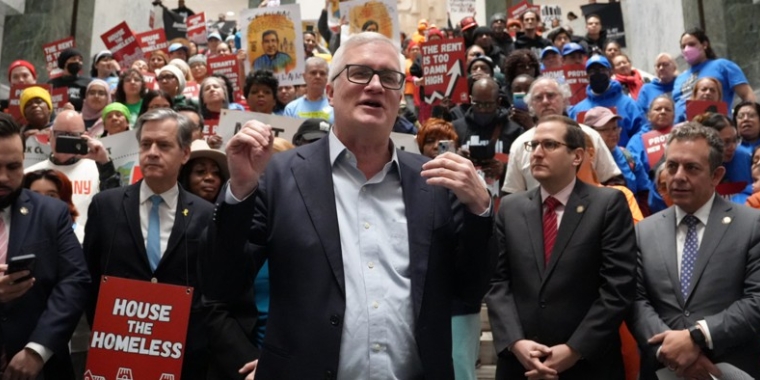Brooklyn Eagle: Cobble Hill’s ‘Fix the Ditch’ Plan Comes Roaring Back to Life

On March 5, 2020, Mary Frost of the Brooklyn Daily Eagle reported on a forum Senator Kavanagh and other public officials attended to discuss potential options for reconstruction of the Brooklyn-Queens Expressway. Kavanagh is quoted regarding the potential for State legislation to provide a mechanism for carrying out a large-scale project. The full text of this story is below; the original version is available at the link above.
_______________
Cobble Hill’s ‘Fix the Ditch’ Plan Comes Roaring Back to Life
By Mary Frost
March 5, 2020
Fixing the Brooklyn-Queens Expressway is much bigger than just rebuilding the triple cantilever holding up the Brooklyn Heights Promenade, Cobble Hill residents said at a town hall last week.
Now is the time to act to deck over the notorious BQE trench that has divided the neighborhood for more than 60 years, speakers at the BQE Future Vision event said. The event was organized by the Cobble Hill Association.
“We can now seize the moment, we can’t let it pass,” New York City Comptroller Scott Stringer told the crowd. “We have to act now and be decisive.”
Last week the Brooklyn Heights Association celebrated the demise of the city’s controversial plan that would have run a temporary six-lane BQE bypass over the beloved Promenade.
But that was just the first step, according to a coalition of about a dozen neighborhood organizations.
The Coalition for the BQE Transformation wants to transform the entire BQE corridor into “an urban highway for the next century.”
For Cobble Hill, this means reviving an 18-year-old idea — dubbed “Fix the Ditch” — to build a deck over the BQE trench. The trench was constructed by Robert Moses in the 1950s, and it split Cobble Hill and Carroll Gardens off from what is now called the Columbia Street Waterfront District. Since then, the below-grade highway has subjected these neighborhoods to noise pollution and emissions from 14,000 trucks a day.
“I think there’s momentum now,” Cobble Hill Association President Amy Breedlove told the crowd at P.S. 29. “We are united in the fight for a plan to combat air quality, create green space and reduce the number of vehicles on surface streets. Now we have to get a winning plan on the table.”
Stringer was the first to offer an alternate BQE plan that included a green deck over the trench.
Adam Forman, chief policy and data officer for the NYC Comptroller’s Office showed the crowd examples of other cities — Dallas, Phoenix, San Francisco, Seoul —where highways had been capped to create acres of park. Capping the Cheonggyecheon Freeway in Seoul resulted in a 5- to 6-degree temperature drop in the surrounding area, he said.
Another proposal, created by DUMBO’s Bjarke Ingels Group (and a similar plan designed by Heights resident Mark Baker) could also be extended to cap the trench, the designers said.
The BQE corridor is 17.4 miles long, but “it’s important to break it into chunks you can build on,” Jeremy Alain Siegel from BIG said. The first chunk needing attention “is the Brooklyn Heights/DUMBO/Cobble Hill section,” but there is potential for a continuous linear park running from DUMBO to Red Hook.”
Another approach, one of two recommended by the New York City Council, would replace a section of the BQE with a three-mile long tunnel from the Gowanus Canal to the Brooklyn Navy Yard. The BQE from Cobble Hill to Clinton Hill could be converted into a surface street and new open space.
Part two: Strategy and New Legislation
Now what’s needed is to create “an intergovernmental entity” with the authority over the BQE rehabilitation, Stringer said. “We need a government authority that is a partnership between the state and the city.”
“How do we get from A to D? Once the idea phase is done, we have to think politically,” he said. “Part two is strategy. That will involve [state] Sen. Brian Kavanagh and Assemblymember Jo Anne Simon in Albany.”
“It’s clear that nothing very good will come of this unless we find a way for engagement and cooperation across all levels of government,” Kavanagh said. “A project of this scale will require some coordinating entity.” And new legislation will be required to create that entity, he said.
“How to make this happen?” Simon asked. “This is going to take some time; strategy doesn’t happen overnight … We have to research governance models; we’re doing due diligence.”
Dan Wiley, district director for U.S. Rep. Nydia Velazquez, said that back in 2010 the Congresswoman secured $300,000 in federal funds to study the idea of capping the trench. The city’s Economic Development Corp kicked off a BQE Enhancement Study, carried out by Starr Whitehouse Landscape Architects and Planners.
Design workshops held with the Cobble Hill Association (under then-President Roy Sloane) and the EDC produced three different options.
But the project was never funded and the state walked away from it.
In the short term, a 1.5-mile stretch of the BQE is in immediate need of repairs to keep it usable while a master plan is being created. That plan needs to include neighborhoods all along the corridor.
At a recent City Council hearing, Councilmember Carlos Menchaca said that Red Hook and Sunset Park must also be included in the discussion. “We have to look at the whole corridor, not just Brooklyn Heights.”
“At the end of the day we have to fix the BQE short term, and we have to reinvigorate the thoroughfare with a borough-wide approach and multiple levels of government,” Wiley said.
Longtime Brooklyn resident Joseph McCarthy was the man who first came up with the tag line “Fix the Ditch” back in 2002.
“After years of workshops and design reviews, the city resoundingly came back with, ‘No, it’s not going to work,’” McCarthy told the Brooklyn Eagle on Tuesday.
“There are several things I learned since then,” McCarthy said. “The idea was too small, and we hadn’t factored in the cantilever under the Brooklyn Heights Promenade and the possibility that it might be deteriorating.”
However, the recent defeat of the city’s unloved Promenade Highway proposal is in itself quite an accomplishment, McCarthy said.
“It’s a great first step. Getting rid of bad ideas is really important.”



